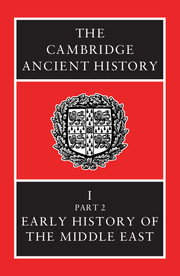Book contents
- Frontmatter
- Contents
- List of Maps
- List of Tables
- List of Text-figures
- Preface
- CHAPTER XI THE EARLY DYNASTIC PERIOD IN EGYPT
- CHAPTER XII THE LAST PREDYNASTIC PERIOD IN BABYLONIA
- CHAPTER XIII THE CITIES OF BABYLONIA
- CHAPTER XIV THE OLD KINGDOM IN EGYPT AND THE BEGINNING OF THE FIRST INTERMEDIATE PERIOD
- CHAPTER XV PALESTINE IN THE EARLY BRONZE AGE
- CHAPTER XVI THE EARLY DYNASTIC PERIOD IN MESOPOTAMIA
- CHAPTER XVII SYRIA BEFORE 2200 B.C.
- CHAPTER XVIII ANATOLIA, c. 4000–2300 b.c.
- CHAPTER XIX THE DYNASTY OF AGADE AND THE GUTIAN INVASION
- CHAPTER XX THE MIDDLE KINGDOM IN EGYPT: INTERNAL HISTORY FROM THE RISE OF THE HERACLEOPOLITANS TO THE DEATH OF AMMENEMES III
- CHAPTER XXI SYRIA AND PALESTINE c. 2160–1780 b.c.
- CHAPTER XXII BABYLONIA, c. 2120–1800 B.C.
- CHAPTER XXIII PERSIA, c. 2400–1800 B.C.
- CHAPTER XXIV (a) ANATOLIA, c. 2300–1750 B.C.
- CHAPTER XXIV(b) ANATOLIA IN THE OLD ASSYRIAN PERIOD
- CHAPTER XXV ASSYRIA, c. 2600–1816 B.C.
- CHAPTER XXVI(a) GREECE, CRETE, AND THE AEGEAN ISLANDS IN THE EARLY BRONZE AGE
- CHAPTER XXVI(b) CYPRUS IN THE EARLY BRONZE AGE
- CHAPTER XXVII IMMIGRANTS FROM THE NORTH
- BIBLIOGRAPHIES
- Chronological Tables
- Index to Maps
- General Index
- Map 6. Babylonia and Western Persia.
- Map 12. Early Bronze Age sites in Greece and the Aegean Islands.
- Map 16. Map to illustrate movements of northern peoples in the third to first millennia B.C.
- References
CHAPTER XI - THE EARLY DYNASTIC PERIOD IN EGYPT
Published online by Cambridge University Press: 28 March 2008
- Frontmatter
- Contents
- List of Maps
- List of Tables
- List of Text-figures
- Preface
- CHAPTER XI THE EARLY DYNASTIC PERIOD IN EGYPT
- CHAPTER XII THE LAST PREDYNASTIC PERIOD IN BABYLONIA
- CHAPTER XIII THE CITIES OF BABYLONIA
- CHAPTER XIV THE OLD KINGDOM IN EGYPT AND THE BEGINNING OF THE FIRST INTERMEDIATE PERIOD
- CHAPTER XV PALESTINE IN THE EARLY BRONZE AGE
- CHAPTER XVI THE EARLY DYNASTIC PERIOD IN MESOPOTAMIA
- CHAPTER XVII SYRIA BEFORE 2200 B.C.
- CHAPTER XVIII ANATOLIA, c. 4000–2300 b.c.
- CHAPTER XIX THE DYNASTY OF AGADE AND THE GUTIAN INVASION
- CHAPTER XX THE MIDDLE KINGDOM IN EGYPT: INTERNAL HISTORY FROM THE RISE OF THE HERACLEOPOLITANS TO THE DEATH OF AMMENEMES III
- CHAPTER XXI SYRIA AND PALESTINE c. 2160–1780 b.c.
- CHAPTER XXII BABYLONIA, c. 2120–1800 B.C.
- CHAPTER XXIII PERSIA, c. 2400–1800 B.C.
- CHAPTER XXIV (a) ANATOLIA, c. 2300–1750 B.C.
- CHAPTER XXIV(b) ANATOLIA IN THE OLD ASSYRIAN PERIOD
- CHAPTER XXV ASSYRIA, c. 2600–1816 B.C.
- CHAPTER XXVI(a) GREECE, CRETE, AND THE AEGEAN ISLANDS IN THE EARLY BRONZE AGE
- CHAPTER XXVI(b) CYPRUS IN THE EARLY BRONZE AGE
- CHAPTER XXVII IMMIGRANTS FROM THE NORTH
- BIBLIOGRAPHIES
- Chronological Tables
- Index to Maps
- General Index
- Map 6. Babylonia and Western Persia.
- Map 12. Early Bronze Age sites in Greece and the Aegean Islands.
- Map 16. Map to illustrate movements of northern peoples in the third to first millennia B.C.
- References
Summary
THE EARLY MONARCHY AND THE UNIFICATION OF EGYPT
Tradition and a substantial body of indirect evidence suggest strongly that Egypt, in the period immediately preceding the foundation of the First Dynasty, was divided into two independent kingdoms: a northern kingdom, which included the Nile Delta and extended southwards perhaps to the neighbourhood of the modern village of Atfīh (Lower Egypt) and a southern kingdom comprising the territory between Atfīh and Gebel es-Silsila (Upper Egypt). The residences of the kings are believed to have been situated at Pe, in the north-west Delta, and at Nekhen (Hierakonpolis), on the west bank of the river near Edfu, both of which, in historical times at least, possessed important sanctuaries of the falcon-god Horus, the patron deity of the rulers. In the vicinity of Pe lay Dep, the seat of a cobra-goddess Uadjit (Edjo); the two places were together known in the New Kingdom and later under one name Per-Uadjit (House of Edjo), rendered as Buto by the Greeks. Across the river from Nekhen stood Nekheb (El-Kāb), where a vulture-goddess Nekhbet had her sanctuary. Both goddesses came to be regarded at a very early date, perhaps while the separate kingdoms were in being, as royal protectresses.
Even such information about this period as was recorded in the king-lists is largely lost and what remains is difficult to interpret. The first line of the fragmentary Palermo Stone consists of a series of compartments, seven only being entirely preserved, each of which contains a name and a figure of a king wearing the crown of Lower Egypt, but no historical events are mentioned.
- Type
- Chapter
- Information
- The Cambridge Ancient History , pp. 1 - 70Publisher: Cambridge University PressPrint publication year: 1971
References
- 5
- Cited by

